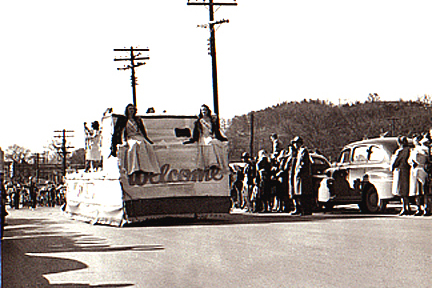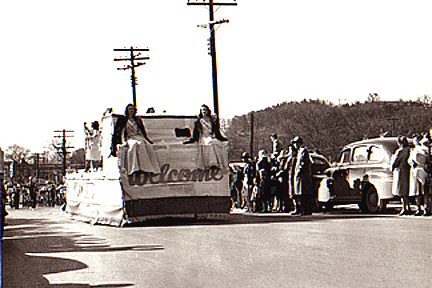Between 1945 and 1956, the traditional annual Thanksgiving Day dinner was sandwiched tightly between two separate Burley Bowl celebrations. This much anticipated event consisted of a parade held in downtown Johnson City in mid-morning, followed by a football game at Memorial Stadium in the afternoon.
Both heavily attended proceedings originated soon after the close of World War II as a way to celebrate the opening of the upcoming tobacco market season. I have warmhearted memories of this parade, attending it with my father for as far back as I can recall. Almost without exception, the weather was cold and blustery, occasionally with light snow or flurries and requiring us to dress appropriately. A thermos of hot chocolate was a necessary ingredient in our survival kit.
Dad and I always left early that morning, usually parking our car along Boone Street between King and Millard streets. The downtown portion of Main Street had previously closed to vehicle traffic, restricting it for pedestrian use. Such action allowed sufficient space for the massive parade and sprawling crowd.
The parade route originated in front of City Hall at Main and Boone streets, with stationary floats and school bands positioned bumper-to-bumper for a distance extending west, well beyond West Side School. Each of the numerous community clubs in the county sponsored a float and simultaneously entered a pretty contestant in the Burley Bowl queen competition. Dad and I claimed our favorite spot in front of the Tennessee Theatre, a location that permitted us to view the parade at its point of origin while it was “fresh.”

At the precise designated start time, the procession began to the accompanying cheer of the crowd. It journeyed east to Memorial Stadium, a pilgrimage of nearly a mile. What followed was a volley of police and fire vehicles with sirens blaring and lights flashing, city officials riding in convertibles, colorfully decorated floats (usually with a hint of tobacco displayed), area school bands and outrageously dressed clowns.
One year, a family member invited us to join them in viewing the parade from their second story Franklin Apartments residence at the corner of Division Street. While I enjoyed the warm unobstructed view of the spectacle while kneeling at a window, I missed the exhilaration of being part of the shivering crowd below. The parade always concluded with jolly old Saint Nick, perched high on a fire engine, waving and tossing goodies to his enthusiastic youthful congregation below.
After the pageant ended, Dad and I navigated through the dense, almost impenetrable, mob to our car. We then drove home to feast on the scrumptious Thanksgiving dinner that Mom had prepared for us.
The Burley Bowl football game began in early afternoon, with the previously selected homecoming queen crowned during halftime. According to the late Ray Stahl’s book, “Greater Johnson City: A Pictorial History,” twelve colleges and universities participated in the event during its relatively short history: East Tennessee State College, Milligan College, Emory and Henry College, Carson-Newman College, High Point (North Carolina) College, Southeastern Louisiana College, West Chester (Pennsylvania) College, Appalachian State University, Hanover (Indiana) College, Morris Harvey (West Virginia) College, Lebanon Valley (Pennsylvania) College and Memphis State University. East Tennessee State College joined the competition in 1952, playing in the last five games and winning three of them.
After the 1956 Burley Bowl tobacco market celebration concluded, the event went up in smoke and quickly vanished into yesteryear.

Comments are closed.